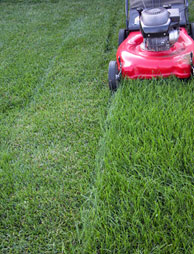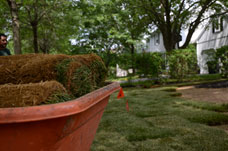
Seeding or Reseeding a Lawn
Many turf experts regard seeding as the best way to establish a lawn. With proper care, newly germinated grass seed will grow deep roots, which help to keep it healthy during harsh weather and times of drought. Growing a lawn from seed is not a fast process. It will take several weeks or months for your turf to look dense, full and green.
If you do not need to start a new lawn from scratch, reseeding is the way to go. For sparse, thin lawns, as long as you do the right preparation, reseeding is an effective way to renovate your yard. It also allows for customization of seed mixes. With seed, it is easy for the experts at Wright Landscape Services to pick the best blend of grass species for the conditions in your yard.
Sod for a New Lawn

Soil Preparation
Whether you are seeding or sodding your lawn, the most important part of the project is the preparation work. Without good soil and growing conditions, your new lawn is destined for failure. Till the existing soil to at least six inches depth, mixing in compost and any other soil amendments. A soil test is the best way to get recommendations for any fertilization that may be needed.
After tilling, rake out large stones, sticks and other debris. Make sure the surface of the soil is smooth and free of low spots or mounds. Then, you will be ready for your seed or sod. If you are reseeding without removing existing grass, you will want to aerate the soil and apply a topdressing of compost rather than tilling.
Spring and fall are the best times to establish a new lawn. Spring gives you a longer growing season, but water demands will be higher with hot weather approaching. Fall planting, if timed right, allows roots to get established over winter. Come spring, you should have new, healthy growth.
There is no right or wrong answer for the question of seed or sod. It depends on your time frame, budget and the specific conditions in your yard. Whichever you choose, watching a new lawn become established is one of the most rewarding experiences you will have as a homeowner and gardener. A lush, green expanse of grass is a beautiful focal point for any landscape.
Call our residential landscaping experts today for an estimate on your new seed or sod lawn.

Ready to make your dreams come true?
Learn our planning secrets and get started with turning a yard redesign into a reality.
- Budgeting tips
- How to set priorities
- What to ask your architect

